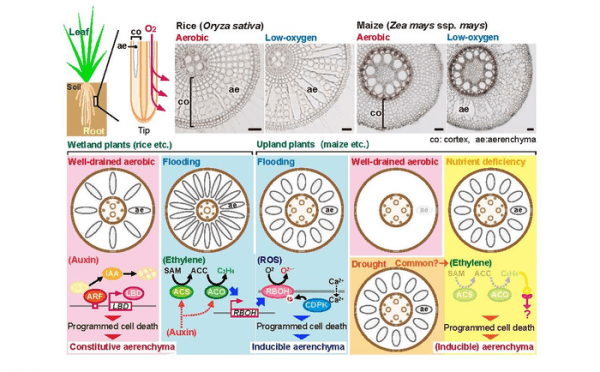Wetland plants have a high tolerance against flooding due to the formation of "lysigenous aerenchyma," air channels that help transfer gases to the submerged roots. These channels also help the plant withstand drought and nutrient deficiency. Now, scientists from Japan investigate the underlying mechanism of aerenchyma formation to understand the phenomenon better, opening doors to the development of crops that are resilient against extreme weather changes.
Floods and droughts are the main environmental disasters responsible for most crop failures. Aerenchyma formation can help crops cope with these environmental stresses. However, it is not commonly observed in non-wetland species like wheat and maize, which are staple food crops in certain areas of the world. Researchers Takaki Yamauchi and Mikio Nakazono from Nagoya University, Japan, have surveyed literature on the topic to get a concrete overview of the various factors involved in aerenchyma formation. "If we can genetically control the timing and amount of lysigenous aerenchyma formation in roots of all agronomically important crops, such as maize, wheat and soybean, the global crop production loss could be dramatically reduced," says Dr. Nakazono.
Dr. Yamauchi and Dr. Nakazono suggest imagining the lysigenous aerenchyma to a snorkel used to breathe underwater. During flooding, the roots get cut off from oxygen and other vital gases needed for survival. In response, the plant creates air pathways connecting the submerged regions of the plant to the parts above water. Similar to a snorkel, these pathways help the plant "breathe" by transporting gases to the submerged roots. Moreover, the air channels reduce the energy requirement for the breathing process and can help the plant conserve energy during extreme conditions of drought or nutrient deficit.
Read more at Nagoya University
Image: Under well-drained (aerobic) conditions, wetland plants form aerenchyma constitutively. Auxin signaling regulates programmed cell death (PCD) during constitutive aerenchyma formation in the roots of a wetland plant rice. Under flooding (low-oxygen) conditions, ethylene production increases and then ethylene stimulates the generation of reactive oxygen species (ROS). Moreover, cytosolic Ca2+ further stimulates the ROS-mediated PCD. PCD is not triggered by auxin signaling in upland plants, whereas the ethylene–ROS signaling could be common. Although the ethylene production decreases, ethylene signaling is stimulated by nutrient deficiency. So far the mechanism underlying drought-induced aerenchyma formation is unknown. Abbreviations: ACC, 1-aminocyclopropane-1-carboxylic acid; ae, aerenchyma; co, cortex; ep, epidermis; IAA, indole-3-acetic acid; P, phosphorylation; ROS, reactive oxygen species; SAM, S-adenosyl-methionine; st, stele. (Credit: Takaki Yamauchi)


